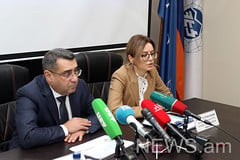By Mariam Levina
YEREVAN. – An interview of Ambassador Andrzej Kasprzyk, the Personal Representative of the OSCE Chairperson-in-Office, with Armenian News-NEWS.am.
According to the statistical data provided by the sides in the Nagorno-Karabakh conflict, over the past years the number of ceasefire violations increased manifold. In your view, are there any mechanisms to counter the escalation of the number of incidents?
The ceasefire agreement of May 1994 and the political will of the parties are the main factors that determine the situation on the border and the Line of Contact. In February 1995, under the aegis of the OSCE Minsk Group Co-Chairs, procedures to strengthen the ceasefire were elaborated. Moreover, with the agreement and support of the sides, my colleagues and I make frequent visits to the border and the Line of Contact. The aim of these visits is to help build confidence between the sides, and such measures have, on numerous occasions, helped reduce tensions.
How important is, in your view, the issue of withdrawal of snipers from the border between Armenia and Azerbaijan and from the Line of Contact?
According to the relevant authorities, snipers are responsible for the majority of deaths and many of the injuries on both sides of the border and the Line of Contact. Withdrawal of these snipers would save lives and significantly reduce levels of tension. By agreeing to withdraw them, the sides would also boost each other’s confidence and so create an atmosphere more conducive to fruitful negotiations.
How effective is, in your view, OSCE monitoring? Is there a need to expand the mandate of the Personal Representative and to increase the number of field assistants?
Visits by OSCE teams to the border and the Line of Contact are no substitute for a ceasefire verification mechanism, such as those that can be seen in many other parts of the world. Nonetheless, local commanders and others continue to tell us that our visits provide valuable opportunities for those involved to address issues of mutual concern and, where necessary, to mitigate the risk of any escalation. These visits also enable us to convey to the OSCE Chairperson-in-Office and the OSCE Minsk Group Co-Chairs, information about the situation as seen by those on the ground.
As for the mandate of the Personal Representative, this is determined through consensus by the OSCE participating States, including Armenia and Azerbaijan.
What is your view on the idea to conduct lengthier (several days long) monitoring and monitoring without giving prior notice?
OSCE teams usually visit the border or Line of Contact every couple of weeks - sometimes for a few hours, sometimes longer. In April 2013, for example, my colleagues and I visited two parts of the Line of Contact on consecutive days.
It is my duty to work with the sides to develop measures that will help the sides reach a lasting political settlement. As far as monitoring activities are concerned, the main challenges are ensuring the safety of all those involved, including security guarantees, and securing the resources needed to implement such measures. For these reasons, unannounced visits to the border or Line of Contact are not possible.
Are there mechanisms for the implementation of the so-called Astrakhan agreements?
In Astrakhan in October 2010, at the invitation of the president of Russia, the presidents of Armenia and Azerbaijan agreed in a statement to implement an exchange of prisoners of war and return dead bodies, with the support of the Minsk Group Co-Chairs and the ICRC. I continue to co-operate closely with all involved in promoting and facilitating the return of prisoners of war and dead bodies, as well as of civilian detainees.
Is there a possibility to create mechanisms on the investigation of incidents on the border and on the line of contact? Does the group that you lead, nevertheless, conduct independent investigation of incidents?
Our teams have neither the mandate nor the resources required to investigate reported incidents.
Ambassador, you have held a position of the OSCE CiO Personal Representative for quite a few years. What would you wish to the sides in conflict?
I am privileged to meet, talk to and work with Armenian and Azerbaijani men and women of different generations from across this region. Some are people with dynamic public profiles; others are private individuals. The lives of almost all of them alike are marked by the conflict and its consequences. Among them are a number of people who not only long for peace and for reconciliation but are also energetically engaged in achieving these. I wish them every success and hope that we can continue to work together towards what are our common goals.
Mariam Levina
















